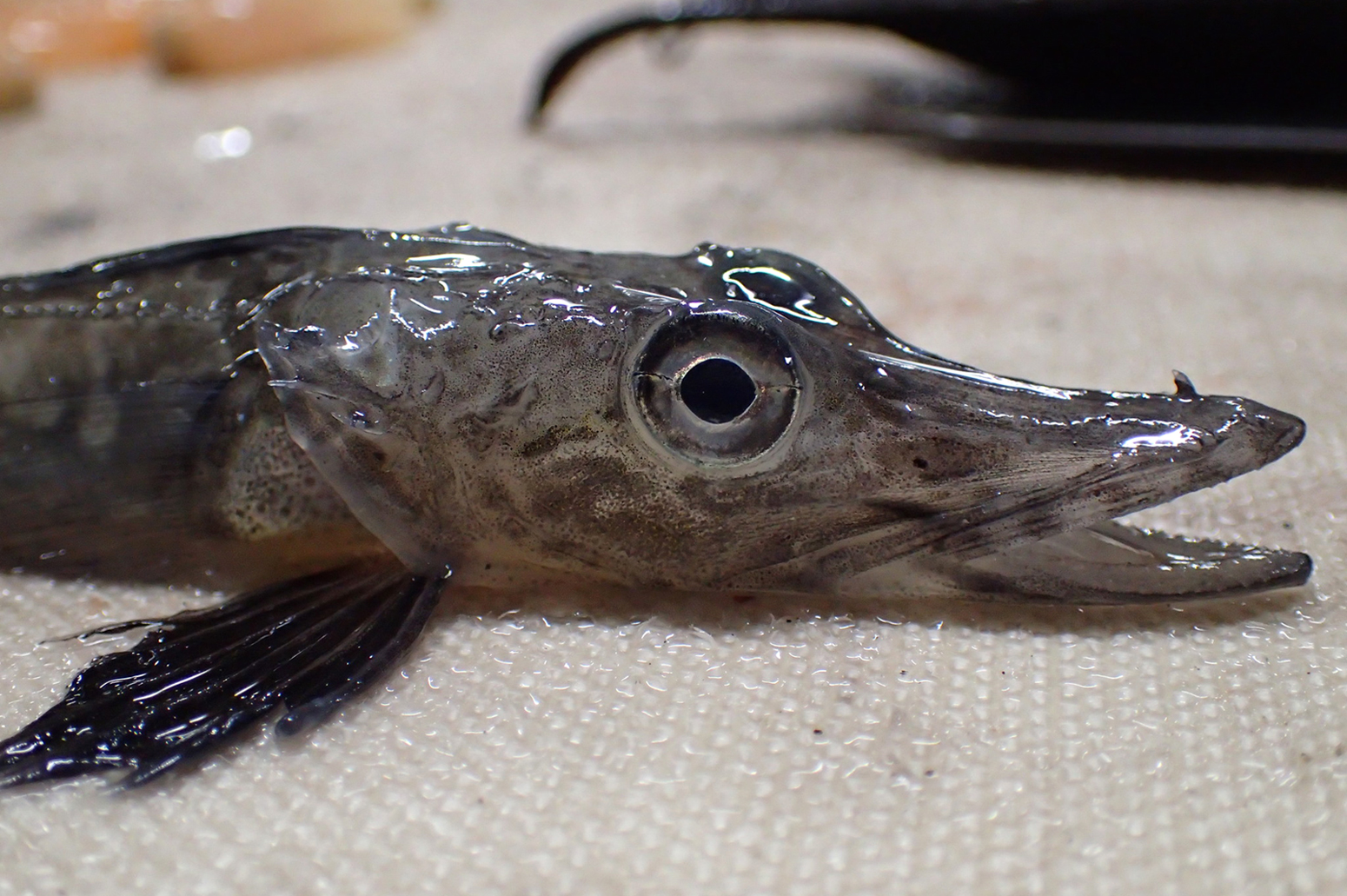- Classification
- ACTINOPTERYGII
- PERCIFORMES
- CHANNICHTHYIDAE
- Channichthys
- rhinoceratus
Unicorn Icefish, Channichthys rhinoceratus Richardson 1844
Other Names: Common Unicorn Icefish

A Unicorn Icefish, Channichthys rhinoceratus, from the Australian Territory of Heard and MacDonald Islands, May 2015. Source: Dale Maschette / iNaturalist.org. License: CC by Attribution-NonCommercial-ShareAlike
Summary:
Variable in colour - mostly pale brown with darker spots and reticulations, and often reddish patches, a blackish first dorsal fin with or without small dots, and pale to dusky fins. Juveniles have four dark bars along the side.
Icefishes are unique among vertebrates in lacking haemoglobin and red blood cells to transport oxygen throughout the body.
Icefishes are unique among vertebrates in lacking haemoglobin and red blood cells to transport oxygen throughout the body.
Cite this page as:
Bray, D.J. 2024, Channichthys rhinoceratus in Fishes of Australia, accessed 02 Jul 2025, https://fishesofaustralia.net.au/Home/species/5067
Unicorn Icefish, Channichthys rhinoceratus Richardson 1844
More Info
|
Distribution |
Heard and McDonald Islands. The species is endemic to the Kerguelen-Heard Plateau in the Southern Ocean. |
|
Features |
Dorsal fin VI-XI+30-35; Anal fin 27-34; Pectoral fin 18-23; Branched caudal rays 11; Gill rakers, lower arch 8-14; Vertebrae (21-24) -I- (29-34) = 53-58. Body depth 10.5-16.5% SL; head length 37.3-41.3% SL; pelvic-fin length 12.5-19.6% SL. Snout length 44.4-49.8% HL; eye diameter 12.9-18.7% HL; interorbital width 12.7-19.6% HL. Maxilla extending to below anterior third of eye or beyond. Preopercular-mandibular canal not joined to temporal canal. Upper lateral line ending behind last second dorsal-fin ray; middle lateral line usually restricted to caudal peduncle, but sometimes with isolated plates along middle of body. Interorbital region relatively narrow and strongly concave. Supraorbital ridges developed and crenulated in large specimens. Lower part of posterior margin of subopercle serrated in large specimens. Pelvic fins not reaching anus. |
|
Fisheries |
Taken as bycatch in bottom trawls, and of minor commercial importance. |
|
Remarks |
Icefishes are unique among vertebrates in lacking the oxygen-binding protein haemoglobin and red blood cells to transport oxygen throughout the body. Icefishes also lack functional haemoglobin genes. Anti-freeze proteins in their bodies enable them to survive the sub-zero waters of the Southern Ocean around Antarctica. |
|
Etymology |
The specific name is from the Latin rhinos (= nose) and ceratus (= horned), in reference to the spine on the snout of this species. |
|
Species Citation |
Channichthys rhinoceratus Richardson 1844, Annals and Magazine of Natural History (New Series) 13(86) (52): 461. Type locality: Kerguelen Island. |
|
Author |
Bray, D.J. 2024 |
|
Resources |
Unicorn Icefish, Channichthys rhinoceratus Richardson 1844
References
Balushkin, A.V. 1996. Similarity of fish of family Channichthyidae (Notothenioidei, Perciformes); with remarks on the species composition of the family and description of a new species from the Kerguelen Archipelago. Journal of Ichthyology 36(1): 1-10
Balushkin, A.V. 2000. Morphology, classification, and evolution of notothenioid fishes of the Southern Ocean (Notothenioidei, Perciformes). Journal of Ichthyology 40 (Supplement 1): 74-109
Arthur, L. & DeVries, A.L. 1988. The role of antifreeze glycopeptides and peptides in the freezing avoidance of antarctic fishes. Comparative Biochemistry and Physiology Part B: Comparative Biochemistry 90(3): 611-621, https://doi.org/10.1016/0305-0491(88)90302-1.
Eastman, J.T. & Eakin, R.R. 2000. An updated species list for notothenioid fish (Perciformes; Notothenioidei), with comments on Antarctic species. Archive of Fishery and Marine Research 48(1): 11-20
Iwami, T. & Kock, K.-H. 1990. Channichthyidae. pp. 381-399 in Gon, O. & Heemstra, P.C. (eds). Fishes of the Southern Ocean. Grahamstown : J.L.B. Smith Institute of Ichthyology 462 pp.
Kock, K.-H. 2005. Antarctic icefishes (Channichthyidae): a unique family of fishes. A review, Part I. Polar Biology 28: 862-895.
Kock, K.-H. 2005. Antarctic icefishes (Channichthyidae): a unique family of fishes. A review, Part II. Polar Biology 28: 897-909.
Kock, K.-H. & Kellermann, A. 1991. Reproduction in Antarctic notothenioid fish. Antarctic Science 3(2): 125-150.
Kock K.-H., Pshenichnov, L.K. & Devries, A.L. 2006. Evidence for egg brooding and parental care in icefish and other notothenioids in the Southern Ocean. Antarctic Science 18(2): 223–227.
Loeb, V.J., Kellermann, A.K., Koubbi, P., North, A.W. & White, M.G. 1993. Antarctic larval fish assemblages: a review. Bulletin of Marine Science 53(2): 416-449.
Miller, R.G. 1993. History and Atlas of the Fishes of the Antarctic Ocean. Carson City, Nevada : Foresta Institute for Ocean and Mountain Studies i-xx + 792 pp.
Near, T.J., Parker, S.K. & Detrich, H.W. III. 2006. A genomic fossil reveals key steps in hemoglobin loss by the antarctic icefishes. Molecular Biology and Evolution 23: 2008-2016.
Near, T.J., Pesavento, J.J. & Cheng, C.H.C. 2003. Mitochondrial DNA, morphology, and the phylogenetic relationships of Antarctic icefishes (Nototheniidae: Channichthyidae). Molecular Phylogeny and Evolution 28: 87-98. https://doi.org/10.1016/s1055-7903(03)00029-0
Richardson, J. 1844. Description of a new genus of gobioid fish. Annals and Magazine of Natural History New Series 13(86): 461-462 See ref at BHL
Richardson, J. 1844-48. Ichthyology. pp. 1-16 pls 1-6, 7-8 (parts), 9-10 in Richardson, J. & Gray, J.E. (eds). The Zoology of the Voyage of H.M.S. Erebus and Terror under the command of Captain Sir James Clark Ross, R.N., F.R.S., during the years 1839–43. London : E.W. Janson Vol. 2. (as Chaenicthys rhinoceratus) See ref online
Sidell, B.D. & O’Brien, K.M. 2006. When bad things happen to good fish: the loss of hemoglobin and myoglobin expression in Antarctic icefishes. Journal of Experimental Biology 209: 1791-1802.
Voskoboinikova, O.S. 1997. Osteological development of the Channichthyidae (Teleostei: Notothenioidei). Cybium 21(4): 369-379 See ref online
Williams, R. 1983. The inshore fishes of Heard and McDonald Islands, southern Indian Ocean. Journal of Fish Biology 23: 283-292.




